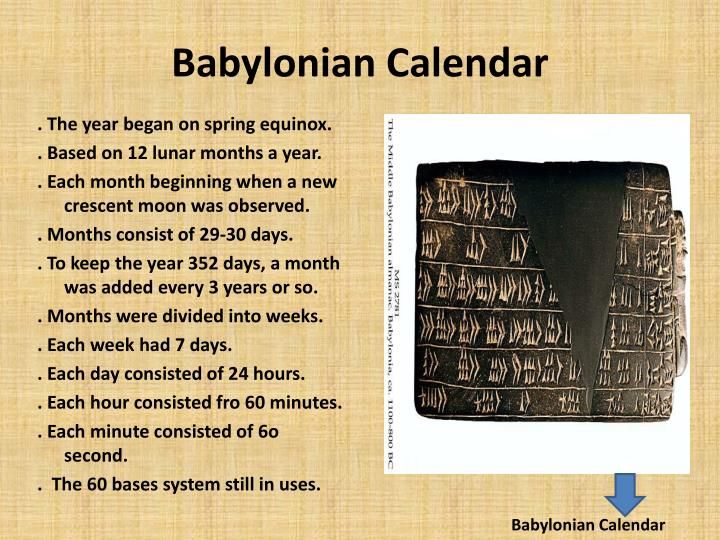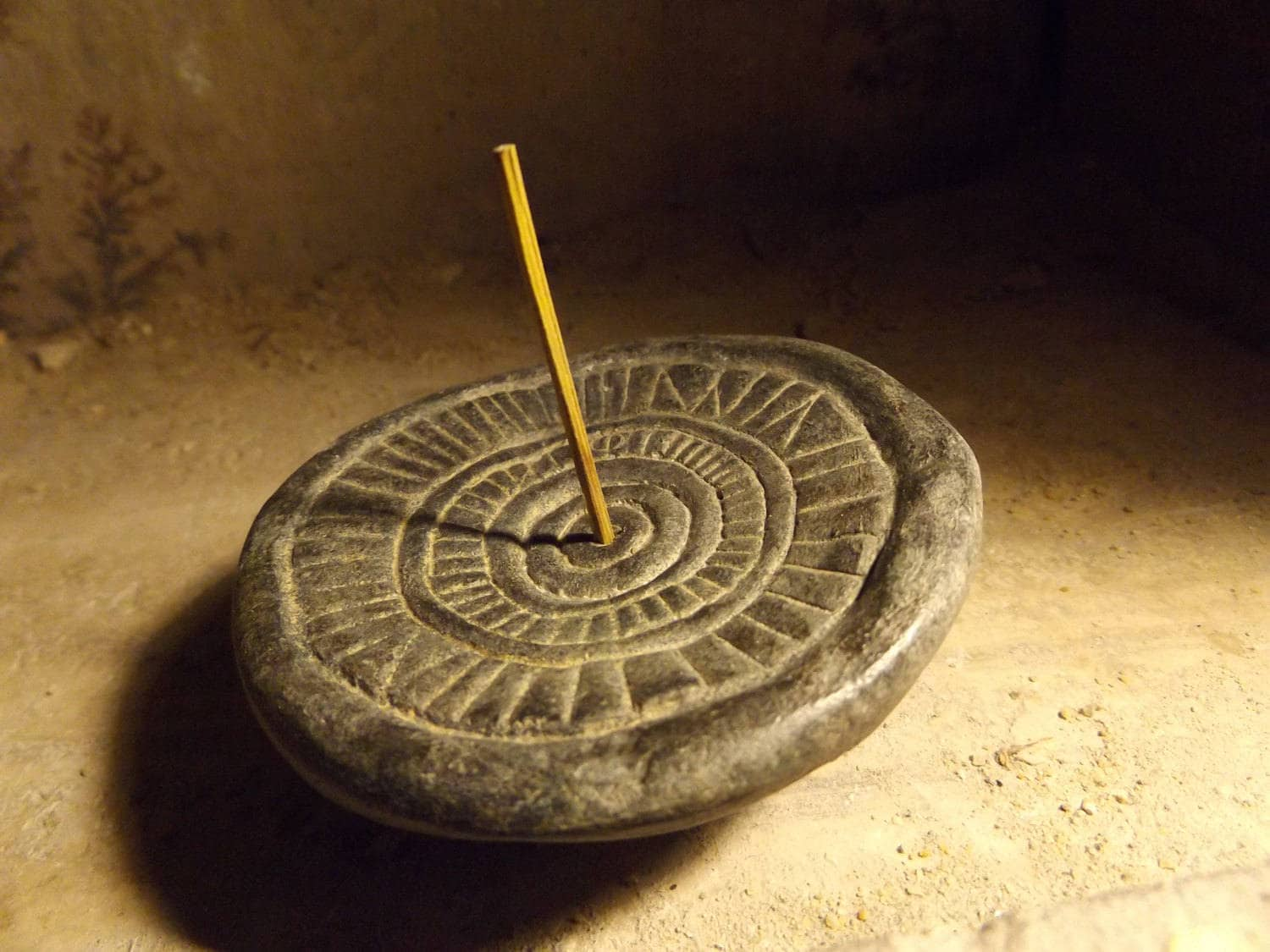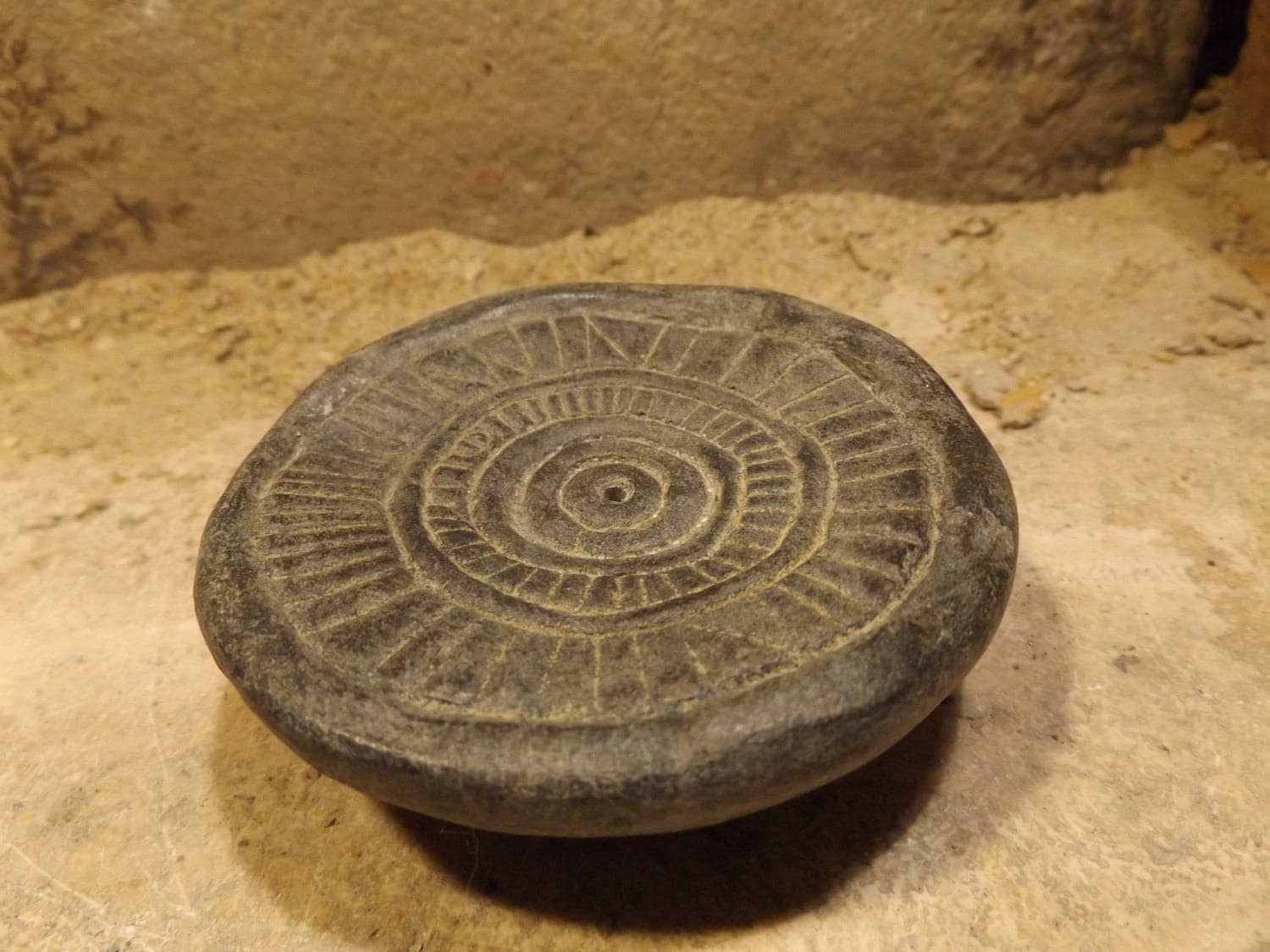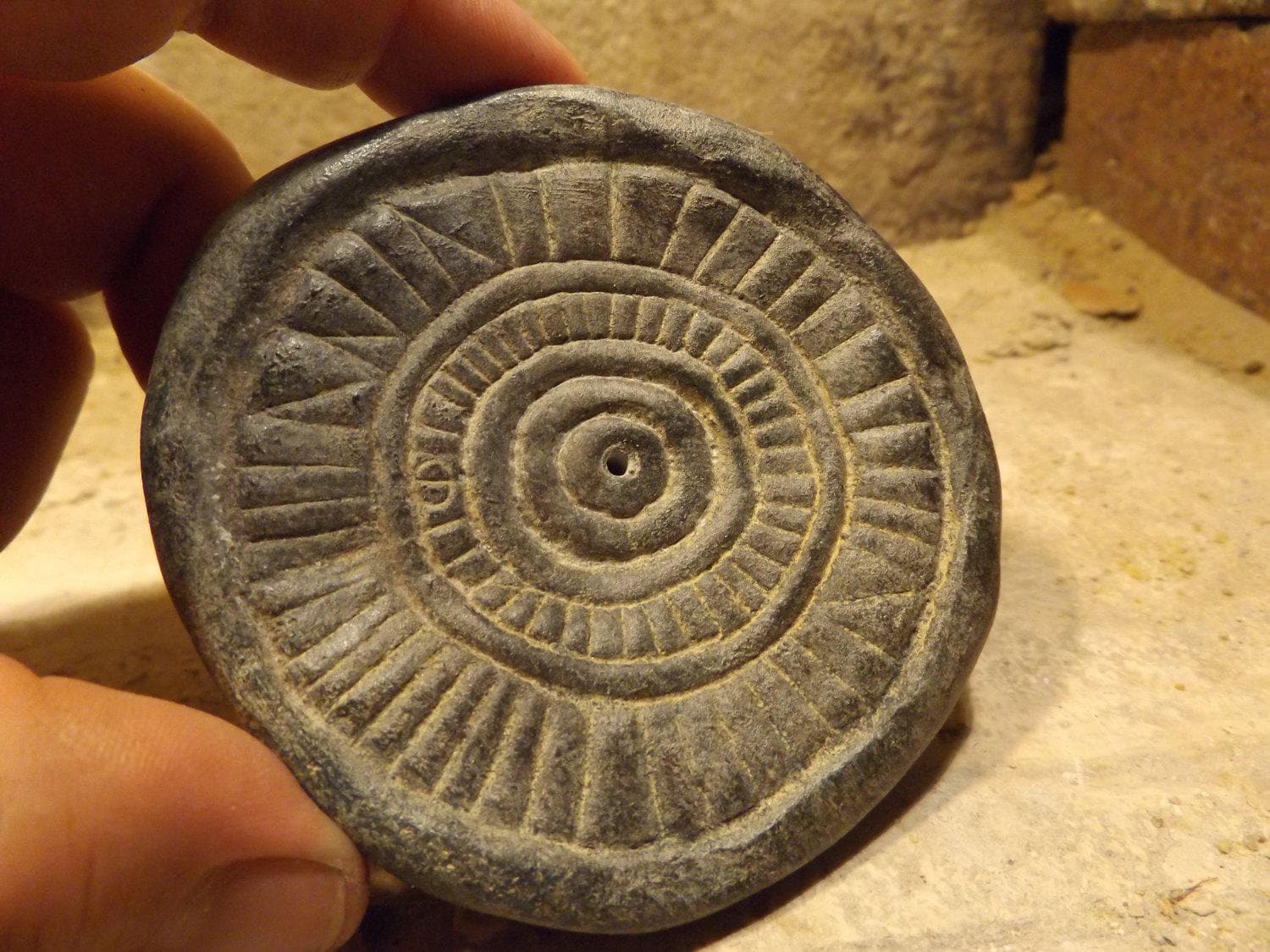Mesopotamian Calendar
Mesopotamian Calendar - Web the babylonian calendar, a remarkable system of timekeeping, offers a fascinating glimpse into the ancient civilization’s organization and understanding of time. The term “babylonian astronomy” is used to refer to a diverse range of practices undertaken by people in ancient babylonia and. Web the civil calendar used throughout ancient mesopotamia was a lunisolar calendar. Web in the 8th century bc, they defined the day as starting when the sun was at the highest point in the sky. Web the mesopotamian calendar system was based on the cycles of the moon and is considered one of their greatest creations. The summer included the barley harvests in the second half of may. The current nippur calendar during the ur iii period was in use in isin and later in larsa and babylon. This chapter discusses the structure of the calendar, local variations, the role. Web learn how the babylonians solved the problem of fitting the lunar months to the solar year by adding leap months based on the cycle of meton. However, the babylonian calendar remained chaotic throughout most.
Web this chapter deals with the standard babylonian calendar that was adopted, in the late second millennium bce, as the official calendar of the empires that ruled the near east. However, the babylonian calendar remained chaotic throughout most. Users can choose from three. The term “babylonian astronomy” is used to refer to a diverse range of practices undertaken by people in ancient babylonia and. Web the civil calendar used throughout ancient mesopotamia was a lunisolar calendar. Web babylonian calendar, chronological system used in ancient mesopotamia, based on a year of 12 synodic months—i.e., 12 complete cycles of phases of the moon. Relevant parts of modern syria, iraq, turkey, and iran, the series „studia chaburensia“ is devoted to the. Web the mesopotamian calendar was based on natural time intervals that characterise the progress of the sun, the cycle of seasons and the motion of the moon. Web the valid range is between march 29, 625 bce (pgc), the accession of the babylonian king nabopolassar, and february 22, 76 ce (pgc). Web geographically encompassing northern mesopotamia, i.e.
The summer included the barley harvests in the second half of may. Web learn how the babylonians solved the problem of fitting the lunar months to the solar year by adding leap months based on the cycle of meton. It was a lunisolar calendar, meaning it was. Web the mesopotamian solar calendar was divided into two season, ‘summer’ and ‘winter’. This chapter discusses the structure of the calendar, local variations, the role. These early systems of timekeeping were pivotal in shaping both. Users can choose from three. Web the civil calendar used throughout ancient mesopotamia was a lunisolar calendar. Web in mesopotamia the solar year was divided into two seasons, the “summer,” which included the barley harvest in the second half of may or in the beginning of june,. Web the mesopotamian calendar was based on natural time intervals that characterise the progress of the sun, the cycle of seasons and the motion of the moon.
Astronomical calendar for the Sumerian civilization (Eckhardt Etheling
The current nippur calendar during the ur iii period was in use in isin and later in larsa and babylon. Web the mesopotamian solar calendar was divided into two season, ‘summer’ and ‘winter’. Web this chapter deals with the standard babylonian calendar that was adopted, in the late second millennium bce, as the official calendar of the empires that ruled.
Mesopotamian Calendar
Web in mesopotamia the solar year was divided into two seasons, the “summer,” which included the barley harvest in the second half of may or in the beginning of june,. Web in the 8th century bc, they defined the day as starting when the sun was at the highest point in the sky. Web this chapter deals with the standard.
Mesopotamian Calendar
Web the civil calendar used throughout ancient mesopotamia was a lunisolar calendar. The current nippur calendar during the ur iii period was in use in isin and later in larsa and babylon. Web the valid range is between march 29, 625 bce (pgc), the accession of the babylonian king nabopolassar, and february 22, 76 ce (pgc). Web the mesopotamian calendar.
Sumerian Calendar
This chapter discusses the structure of the calendar, local variations, the role. Web babylonian calendar, chronological system used in ancient mesopotamia, based on a year of 12 synodic months—i.e., 12 complete cycles of phases of the moon. Web in mesopotamia the solar year was divided into two seasons, the “summer,” which included the barley harvest in the second half of.
Mesopotamian Calendar
Users can choose from three. Web this chapter deals with the standard babylonian calendar that was adopted, in the late second millennium bce, as the official calendar of the empires that ruled the near east. Web the mesopotamian solar calendar was divided into two season, ‘summer’ and ‘winter’. Web the mesopotamian calendar was based on natural time intervals that characterise.
Mesopotamian Calendar
Web the mesopotamian solar calendar was divided into two season, ‘summer’ and ‘winter’. Web during the old babylonian period, each kingdom had its own calendar. Web mesopotamian calendars offer a fascinating glimpse into the ingenuity of ancient civilizations. The term “babylonian astronomy” is used to refer to a diverse range of practices undertaken by people in ancient babylonia and. Web.
Mesopotamian Calendar Was Based On Prue Ursala
Web mesopotamian calendars offer a fascinating glimpse into the ingenuity of ancient civilizations. Web in mesopotamia the solar year was divided into two seasons, the “summer,” which included the barley harvest in the second half of may or in the beginning of june,. It was a lunisolar calendar, meaning it was. These early systems of timekeeping were pivotal in shaping.
Mesopotamian Calendar
Web this chapter deals with the standard babylonian calendar that was adopted, in the late second millennium bce, as the official calendar of the empires that ruled the near east. Web in the 8th century bc, they defined the day as starting when the sun was at the highest point in the sky. Web the mesopotamian solar calendar was divided.
Ancient Mesopotamian Calendar
Web the mesopotamian calendar system was based on the cycles of the moon and is considered one of their greatest creations. Web in the 8th century bc, they defined the day as starting when the sun was at the highest point in the sky. Web the babylonian calendar, a remarkable system of timekeeping, offers a fascinating glimpse into the ancient.
Mesopotamian Calendar
Web the mesopotamian calendar was based on natural time intervals that characterise the progress of the sun, the cycle of seasons and the motion of the moon. Web the babylonian calendar was a lunisolar calendar based on the lunar phases which was used in babylon and surrounding regions for administrative, commercial and ritualistic. The summer included the barley harvests in.
Web The Valid Range Is Between March 29, 625 Bce (Pgc), The Accession Of The Babylonian King Nabopolassar, And February 22, 76 Ce (Pgc).
Users can choose from three. This chapter discusses the structure of the calendar, local variations, the role. This system required the addition of an extra month three times. The summer included the barley harvests in the second half of may.
Web Learn How The Babylonians Solved The Problem Of Fitting The Lunar Months To The Solar Year By Adding Leap Months Based On The Cycle Of Meton.
Web this chapter deals with the standard babylonian calendar that was adopted, in the late second millennium bce, as the official calendar of the empires that ruled the near east. Web the babylonian calendar, developed in ancient mesopotamia around 2000 bce, played a crucial role in the lives of the babylonians. The current nippur calendar during the ur iii period was in use in isin and later in larsa and babylon. Web babylonian calendar, chronological system used in ancient mesopotamia, based on a year of 12 synodic months—i.e., 12 complete cycles of phases of the moon.
Web Geographically Encompassing Northern Mesopotamia, I.e.
Relevant parts of modern syria, iraq, turkey, and iran, the series „studia chaburensia“ is devoted to the. Web in the 8th century bc, they defined the day as starting when the sun was at the highest point in the sky. The term “babylonian astronomy” is used to refer to a diverse range of practices undertaken by people in ancient babylonia and. Web in mesopotamia the solar year was divided into two seasons, the “summer,” which included the barley harvest in the second half of may or in the beginning of june,.
Web The Mesopotamian Calendar Was Based On Natural Time Intervals That Characterise The Progress Of The Sun, The Cycle Of Seasons And The Motion Of The Moon.
Web the babylonian calendar was a lunisolar calendar based on the lunar phases which was used in babylon and surrounding regions for administrative, commercial and ritualistic. It was a lunisolar calendar, meaning it was. Web the babylonian calendar, a remarkable system of timekeeping, offers a fascinating glimpse into the ancient civilization’s organization and understanding of time. Web the civil calendar used throughout ancient mesopotamia was a lunisolar calendar.








